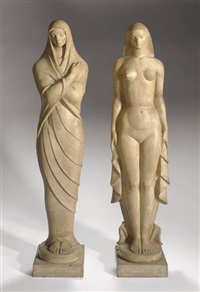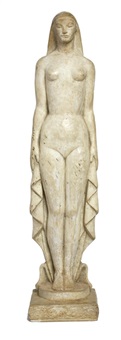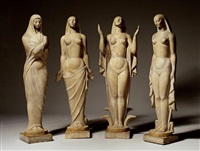
Sculptures By: Wheeler Williams
American, 1897-1972
Names Of Art Sculptures: Spring, Summer, Fall, 1961
Made From: Carrara marble
Gift of the Little Garden Club
62.14.1-3
© Estate of the artist
The Little Garden Club was one of the Brooks Memorial Art Gallery’s support groups that worked hard to improve the surrounding landscape and developed the intimate Holly Court garden, located on the north side of the 1916 building. In 1962 the club presented the museum with sculptures by Wheeler Williams of three of the seasons: Spring, Summer, and Fall. They were moved to their current location on the south side of the 1916 building in 1998. In 1962 the artist donated the smaller-scale bronze Winter that was created in 1934 and is on the lower level of the building.

After the museum expanded the building, the statue of "Summer" disappeared. The companion statues of "Spring", "Fall", and "Winter" are still on display at the museum.

Wheeler Williams
Winter and summer, 1934
Wheeler Williams
Fall, 1934
Wheeler Williams
The four seasons (4 works), 1934
Wheeler Williams (November 30, 1897 – August 12, 1972) was an American sculptor, born in Chicago, Illinois.
Wheeler Williams studied sculpture at the School of the Art Institute of Chicago. He attended Yale where he graduated Magna cum Laude in 1919. He received a Master of Architecture degree from Harvard in 1922. Williams studied at the École des Beaux-Arts in Paris.
He was one of a dozen sculptors invited to compete in the Pioneer Woman statue competition in 1927.,which he failed to win. His model for that competition was later enlarged, cast and placed in front of the public library in Liberty, Kansas.
Williams was a recipient of a Gould Medal at the Paris Exposition in 1937. He was a member of the National Academy, past president of the Fine Arts Federation of New York, and longtime president of the National Sculpture Society. Wheeler was also the founder and president of the American Artist Professional League.
Political Involvement
Williams was a supporter of the House Un-American Activities Committee's search for communist "reds" in the arts. He also protested the Congressional censure of Joseph McCarthy.
Williams also served on the jury for the Alger Hiss treason trial.
Very active in Republican circles, many of Williams' commissions reflect his conservative positions (for example the Robert A. Taft Memorial in Washington, DC).
Public Monuments
- 1930 "Tablets to Pioneers", Michigan Avenue Bridge, Chicago, IL
- 1935 "Communications" West Pediment of the Environmental Protection Agency Building (formerly Interstate Commerce Commission), Federal Triangle, Washington, DC
- 1938 "Indian Bowman," United States Post Office-Canal Street Station, New York, NY
- 1942 "Settlers of the Seaboard", Fairmount Park, Philadelphia, PA
- 1949 "The Venus of Manhattan", Madison Avenue Facade, Parke Bernet Gallery, New York, NY
- 1951 four servicemen sculpture on the Wall of the Missing, Cambridge American Cemetery and Memorial, Cambridge, England
- 1952 "Fountain of the Water Babies", Children's Hospital, Seattle, WA
- 1952 "Wave of Life", Houston Main Building (HMB) of The University of Texas M.D. Anderson Cancer Center; was the Prudential S.W. regional office until 1974. Houston, TX
- 1955 "Robert A. Taft" plaque, Indian Hill Church Cemetery, Indian Hill, OH
- 1956 "Colonel Robert R. McCormick" bronze sculpture, Colonel's Place, Baie-Comeau, QC, Canada
- 1956 Commodore John Barry Memorial, Wexford, Ireland
- 1959 "Robert A. Taft Memorial," Capitol Grounds, Washington, DC
- 1960 "Muse of the Missouri" Fountain, Kansas City, MO
- 1961 "Spring, Summer, Fall," Memphis, TN

Spring, Summer, Fall
ArtistWilliams, Wheeler (1897-1972)
Year1961
This sculpture trio features standing female figures, partially draped; they represent the seasons of spring, summer, and fall. They were originally placed in a niche designed for them on the 1955 wing of the Brooks Museum. They were moved to the current location next to the original 1916 building in 1998.Source: Wikipedia.com


